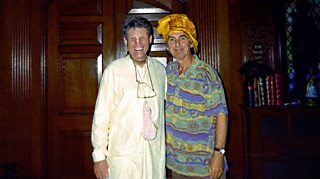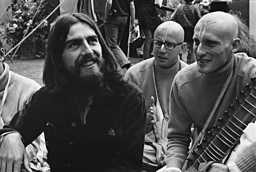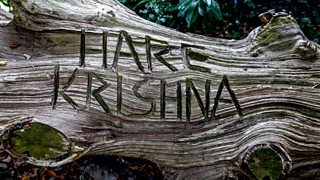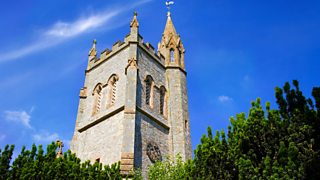My Sweet Lord: How the Hindu god Krishna found a place on George Harrison’s biggest hit

It's 50 years since the UK release of George Harrison’s most successful solo single, My Sweet Lord, that was instrumental in popularising the Hindu divine form of Krishna in the west.
While many of the founding members of the Hare Krishna movement in the UK were part of the 1960s American counterculture, the majority of its followers today are from the British Indian community who are celebrating the birth of Krishna in their thousands in August.
For Radio 4’s Sunday Programme, Vishva Samani spoke to the Hare Krishna member who first introduced the Beatles to their philosophy and enabled Krishna to find a place on George Harrison’s biggest hit.
“George Harrison wanted to know the absolute, no half measures… he wanted it all,” recalls 79-year-old Shyamasundar Das, formerly Sam Speerstra, who renounced a sex, drugs and rock ‘n roll lifestyle in his twenties in favour of embracing the Hare Krishna movement in the '60s.
He came to learn that Krishna is just another name for God… like Allah, Jehovah, Buddha.
He and a group of fellow young Americans who had been part of the counterculture had travelled to London in 1968 with a driving ambition to introduce the Beatles to "Krishna consciousness" following the band’s well-publicised visit to an ashram in India.
After trying different approaches, Shyamasundar Das managed to get an invite to a party within months of arriving in London, where his distinctive shaved head and Indian-style clothing caught George Harrison’s attention.
According to Das, Harrison became increasingly drawn to the idea that devotion was the formula for a perfect life.
“As a famous musician he concluded that he would sing about Krishna and he did so for the rest of his life… he came to learn that Krishna is just another name for God… like Allah, Jehovah, Buddha – there are thousands of names for the same god,” he says.

Exploring the idea that all religions exist on the same level was important to Harrison and intentional when it came to the song writing of My Sweet Lord, according to Dr Ian Inglis, who has written books on the Beatles and George Harrison.

“The real achievement of the song is its lyrics… the way the chorus effortlessly switches between Hallelujah and Hare Krishna is deliberate. Harrison wanted to show that whatever holy name people may choose to worship or use, they are the same thing and express the same element of joy and devotion.”
But how did the unlikely combining of Hallelujah and Hare Krishna happen?
Shyamasundar Das was living in George Harrison’s large country mansion in 1970 doing DIY jobs with a small group of Krishna devotees when Harrison was creating music for his third solo album, All Things Must Pass.
He describes how early one morning he was on a ladder scraping paint when a car pulled up and in rushed Billy Preston, Klaus Voormann and George Harrison with their instruments.
“They continued playing 'Hallelujah… My Sweet Lord…' and from the ladder I just shouted out Hare Krishna, Hare Krishna… and it somehow entered the song after that. It was an immense hit and suddenly the whole world knew about Krishna,” he says.
Visiting the Hare Krishna UK headquarters today – the Bhaktivedanta Manor in Hertfordshire – it’s hard to imagine it was a gift to the movement from a major rockstar. George Harrison bought the property for them in 1973.
Approximately 60,000 mostly Indian-origin worshippers attend vibrant celebrations marking the birth of Lord Krishna there around this time each year, making it the largest celebration of "Janmashtami" outside India. Thousands of samosas are dished out, huge temple queues form and some children and adults even dress up as the blue-skinned divine incarnation at this huge cultural event.
And while those closely associated to the Manor are aware of his enduring connection with the Hare Krishna movement, many attending Janmashtami in 2021 will have little knowledge of the role George Harrison played in popularising Krishna, perhaps most potently through his hit song, My Sweet Lord.
It ended up being George Harrison’s most successful solo release, enjoyed simultaneously as a rock anthem, contemporary gospel and as a prayer that somehow also introduced completely new audiences to Krishna.

How "Hare Krishna" appeared on My Sweet Lord...
Shyamasundar Das on how "Hare Krishna" came to be part of My Sweet Lord.
Dr Ian Inglis thinks it’s precisely because it succeeds at all those things that the song has enduring and broad appeal 50 years on from its UK release.
“It’s been enjoyed by people of different faiths, believers and non-believers," he says, "and is as popular and familiar today as it was then I think.”
-
![]()
Sunday
Listen to Vishva Samani's feature on how the Hindu god Krishna found a place in George Harrison's My Sweet Lord, on Sunday, Radio 4's weekly look at ethical and religious issues.

Spiritual journeys on Radio 4
-
![]()
Sunday Worship
Radio 4's Sunday morning service.
-
![]()
Sunday
A look at the ethical and religious issues of the week.
-
![]()
Daily Service
Regular broadcast of Christian worship and music.
-
![]()
Something Understood
Ethical and religious discussion that examines some of the larger questions of life.





